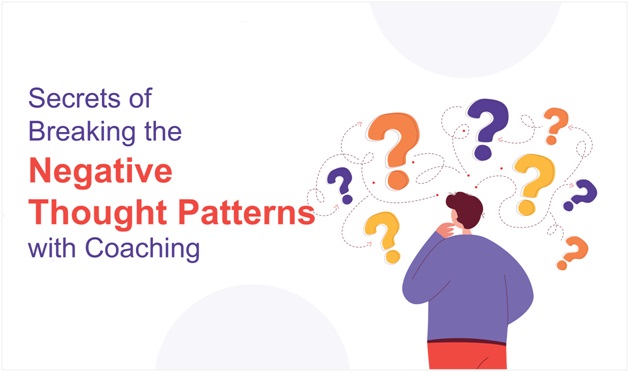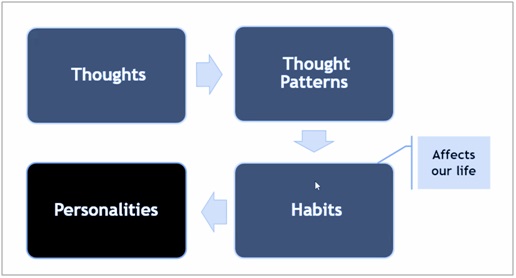This article was first published at International Coach Academy Breaking the Negative Thought Coaching is the beautiful space for making extraordinary bonds and results. It is the place where you can build the trust of making transformation changes in lives. When we create a deeper level of trust and understanding coach can see which coachees...
Secrets of Breaking the Negative Thought Patterns with Coaching

This article was first published at International Coach Academy
Breaking the Negative Thought

Coaching is the beautiful space for making extraordinary bonds and results. It is the place where you can build the trust of making transformation changes in lives. When we create a deeper level of trust and understanding coach can see which coachees can not see.
“Negative Thought Pattern” which is called NTP sometimes people are not aware of as most of the time it is unconscious. In this Research Paper, we are focusing secrets on how these negative thought patterns build and how we can focus coachee to break this pattern with effective coaching.
Natural Tendencies of the mind
Did you know that research from National Science Foundation shows that 95% of our thoughts are repetitive? In that research, close to 80% of the thoughts are negative. We can see that one of the tendencies of the mind is to focus on the negative and “play the same tunes” repeatedly. According to Neuroscience research, Our repetitive thoughts create thought patterns, which make our habits. If we repeat the same routines for a long time, they become a part of our personality. The below diagram explain the same concept it a little broader how your thoughts can form a personality that can be negative and positive.

Why Do We Repeat the Same Negative Thoughts?
According to neuroscience, our brain is negatively biased, which attracts negativity by default. The bias is so automatic that it can, which requires no effort. As humans, we tend to be impacted much more by adverse events than positive ones. As human beings living in the comfort place, we like to get into comfort for all the things because it requires less work for the brain to think the same thoughts repeatedly than it does for the brain to inquire about new ideas. All-day long, we are working or thinking without consciously putting effort into our thinking which puts our minds into auto-pilot mode with the same thinking pattern.
This pattern drives our way of thinking towards the solution which can be biased with the negative patterns. We keep repeating, and then this pattern becomes the personality. Our body responds to any thoughts by secreting hormones that impact our nervous system. For example, if we think someone is threatening or making us uncomfortable, our body will secrete cortisol to prepare us for a fight (or a flee). On the other side, if we feel relaxed, grateful, and acknowledged, Our body will release oxytocin and serotonin as a reward system, helping us feel very good.
Negative Patterns Hold Us Unconsciously to Not Moving Forward
As you sow in your subconscious mind, so shall you reap in your body and environment. ~Joseph Murphy
The biggest secret is this negative pattern holding us unconsciously to move forward. Negative patterns are made up of our way of thinking or behaving, preventing us from being our best self by limiting our achievements and well-being.
This can lead people to withdraw their current awareness and make them feel like they don’t know who they are and what they are doing at the same time. People start living in the same manner and make their comfort zone.
How to Break the Cycle of Negative During Coaching
So, How to break this pattern. Or even how to be aware of there is the negative pattern. Being aware is the key to knowing what is your current emotion. Although it can be challenging to see when you are stuck on the negative merry-go-round, these patterns can provide clues that can lead us towards making positive changes in our daily lives.
Our mind is like a computer’s hard drive. The good news is that just like we can delete and add a new program into computer memory, we can also reprogram data into the subconscious mind.
As coaches, we can bring this awareness with the coachee with the below steps, which we also learn from ICF competencies.
Step 1: Establish Trust and a Safe Environment
The people, when rightly and fully trusted, will return the trust. —Abraham Lincoln
Good coaches build trust with their coachees. They respect them as individuals, preserve confidentiality, and express clearly. This forms a safe space for growth and transformation. Trust is key to maximizing coachees’ ability to explore themselves and achieve their potential by making them feel they are in a trusted environment and are safe to share whatever they want.
Here, Coach needs to focus on allowing the coachee to settle. First, build rapport or, if required, let the coachee calm down. We as a coach should be interested in coachees with empathy and care about their feelings and express this through both words and body language.
One of the first things we learn in life coach training is that our primary job is to “hold space.” As coaches, we establish conditions that allow coachees to access their inner wisdom and formulate answers for themselves.
Step 2: Create Coaching Presence- Be Mentally Present and Engaged
Sometimes holding space feels like doing nothing. – Heather Plett
Coaching presence is the bridge between the coach and the coachee because it’s about being fully present, conscious, and spontaneously connected with the coachee.
It takes practice to be fully present with coachees. We need to listen with our whole self to how they speak about their successes and challenges. We need to listen to many levels at once, such as the words coachees use, their tone of voice, body language, what emotions they might be experiencing, and their self-talk and beliefs about their situation and any energy shift coachees express.
We must pay attention to patterns of thinking and deep listening, including our gut or intuition. Then we can ask permission to share our observations. Bring everything in front of the coachee and ask how it resonates with them. If we feel we have a bias and still think it would serve the coachee to hear what we are sensing or observing, we must own our bias with the coachee.
Step 3 – Creating Awareness to the Coachee
Coaching is to develop the belief that the solution is inside the coachee. Creating awareness during the coaching is an art of coach which brings the coachee to discover self–awareness that will lead them to find the answer that will move them forward to their goal. The coach provides a secure, comfortable environment that allows awareness to emerge by itself.
As the coachee moves through the coaching process, they learn more about themselves. The power of the coaching fibs in the coach learning how to create awareness in their coachee. The coach should bring the goal of creating awareness to all phases of the coaching process. Awareness is a continuous process during the coaching that brings awareness or sometimes called the “Ah-ha” moment, which helps them move forward to finding the solution.
How to Create Awareness Using Breathing or Centering?
Breathing is a powerful technique to increase self-awareness and know the current emotion. In addition, it has excellent benefits like managing stress and increasing our focus, concentration, and the ability to respond thoughtfully to challenges rather than react blindly. Here few steps you can ask your coachee to do during coaching.
- Please Sit in a comfortable chair with both feet on the ground and your spine erect.
- Close your eyes, relax your forehead, eyes, and eyebrows, separate your teeth to release tension in your jaw, and relax your shoulders.
- Rest your awareness on the inhale and exhale of the breath in the body, noticing where you feel more sensation – for example, your nostrils, your belly, or your chest.
- Follow the sensation of an inhale and an exhale, using the breath to anchor your attention into the present moment.
- If your mind rambles, which it is bound to do, bring back your attention to the next breath without judgment and continue.
- Each time your mind spins out into thought, bring it back to following the sensation of the next breath.
Step 4: Empower the Coachee to Draw Some Action From Awareness
The ultimate purpose of coaching is to support our coachees as they learn how to move forward toward their desired outcomes. Once we feel there is an awareness in coaching discussion from the coachee, we can ask questions to move towards realization and next steps. We owe our coachees to be fully present to hear their unique voices and tap their greatness. When we listen with our whole selves and coachees as our total focus, we are more likely to call forth a powerful question that leads to emerging Awareness. When your coachee showed be quiet, stay present, and allow your coachees to grapple with that Awareness and decide what actions to take.
We can ask a question like, “What would you like to do with that new awareness?” even if the action takes more time to reflect on what has emerged. When we are fully present, we will sense whether it’s the right time to ask the coachee if they are ready to move forward or want to stay with the emerging awareness. Partner with the coachee and ask her how they want to move forward. This is the joyful dance of coach and coachee partnering together for increased success.
Overcoming Negative Thinking
Trusting the coaching process and framework, we, as coaches, can bring a lot of value to any coaching conversation. Negative thinking patterns can be hard to break, particularly when they’ve become part of the personality. They are creating the space for the coachee, making them understand their pattern, and helping them move forward to take some action. Patterns that have existed for years won’t be undone overnight, so it’s essential to be compassionate and patient with your coachee as you work through them.
References
Higherselfyoga.org
https://www.psycom.net/negative-thinking
https://www.mindtools.com/
https://www.forbes.com/
“Complementary control over habits and behavioral vigor by phasic activity in the dorsolateral striatum”. Adam C.G. Crego, Fabián Štoček, Alec G. Marchuk, James E. Carmichael, Matthijs A.A. van der Meer and Kyle S. Smith.


